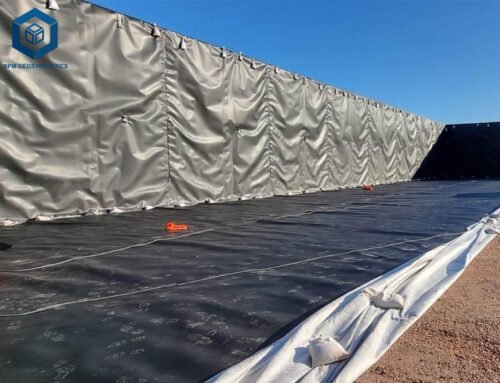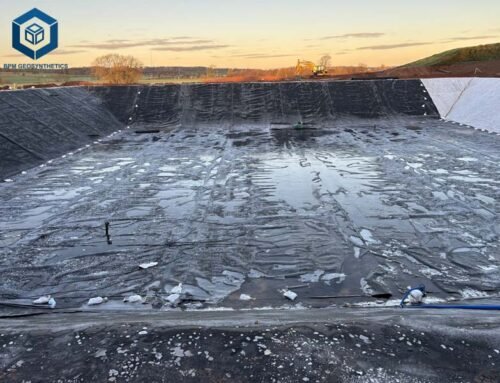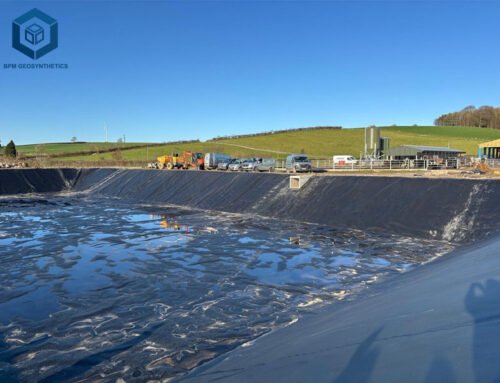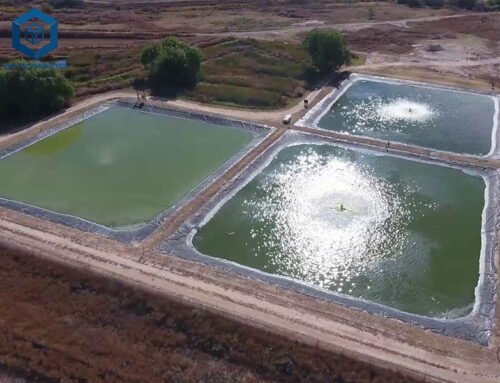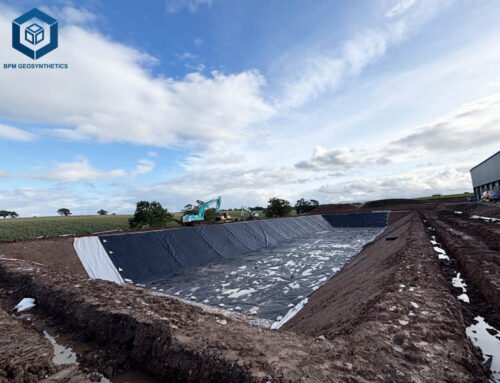Geomembranes are indispensable in civil engineering, providing impermeable barriers for containment in applications such as dredging projects, landfills, ponds, and reservoirs. As a dredging expert, I recognize their vital role in environmental protection and infrastructure stability. With the global geomembrane market valued at USD 2.3 billion in 2024 and projected to grow at a CAGR of 5.4% through 2030, their use is expanding in dredging-related projects for sediment containment and water management. However, Disadvantages of Geomembrane that can affect project outcomes if not carefully managed.
This blog post offers an in-depth exploration of geomembranes, covering their definition, specifications, types, advantages, disadvantages, lifespan, and selection criteria, with a focus on their application in dredging. With data-driven analysis, this guide aims to equip engineers, contractors, and project managers with professional knowledge to optimize dredging and containment projects.
1. What Is a Geomembrane?
A geomembrane is a synthetic, low-permeability liner designed to control fluid or gas migration in geotechnical engineering projects. Typically made from polymeric materials like High-Density Polyethylene (HDPE), these liners provide an impermeable barrier with hydraulic conductivities of 10⁻¹² to 10⁻¹⁵ m/s, far surpassing clay’s performance. In dredging, geomembranes are used to line sediment containment facilities, such as confined disposal facilities (CDFs), to prevent contaminant leaching into waterways. BPM Geosynthetics reports that geomembranes are deployed in 70% of global anti-seepage projects, underscoring their importance in dredging and environmental protection.
2. Key Specifications of Geomembrane
Geomembranes are engineered to meet stringent standards, with specifications tailored to material and application. Below are key parameters for HDPE geomembranes, based on ASTM D7931 and EN ISO 12958 standards, as provided by BPM Geosynthetics:
- Thickness: 0.2–3.0 mm (±10% for smooth, ±15% for textured).
- Width: 1–8 m (±1%).
- Length: 50–100 m per roll (±2%).
- Tensile Strength: ≥27 MPa (ASTM D6693).
- Elongation at Break: ≥700% for smooth, ≥250% for textured.
- Puncture Resistance: ≥320 N for 1.0 mm (ASTM D4833).
- Carbon Black Content: ≥2% for UV resistance (ASTM D4218).
- Water Vapor Permeability: ≤1.0 × 10⁻¹³ g·cm/(cm²·s·Pa).
- Oxidation Induction Time: ≥100 min at 200°C (ASTM D5885).
These specifications ensure geomembranes withstand the mechanical and hydraulic stresses of dredging projects, such as sediment containment in coastal CDFs.

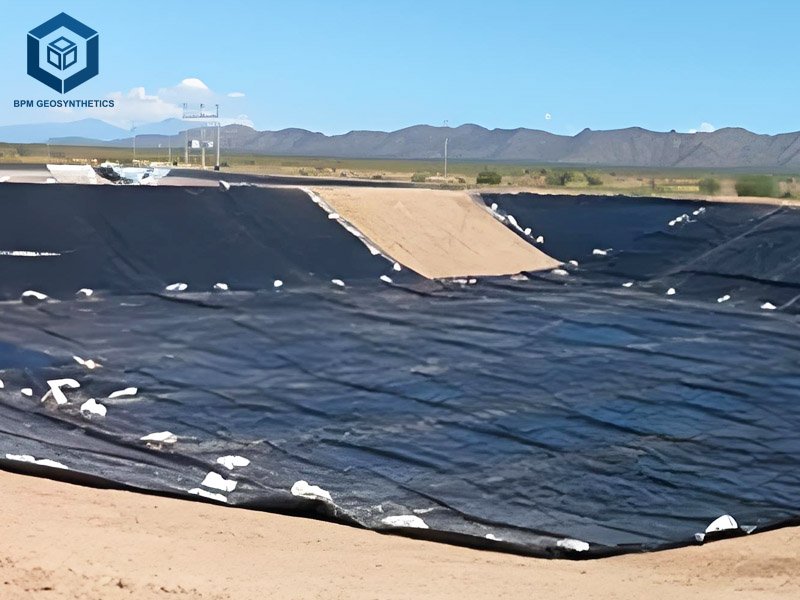
3. What Are Types of Geomembrane?
Geomembranes vary by material, each suited to specific dredging and containment needs:
- High-Density Polyethylene (HDPE): Density 0.94–0.96 g/cm³, used in 65% of landfill and dredging CDFs for its strength and chemical resistance.
- Linear Low-Density Polyethylene (LLDPE): More flexible, ideal for irregular surfaces in ponds and canals.
- Polyvinyl Chloride (PVC): Highly flexible, used in decorative ponds and low-temperature dredging applications.
- Ethylene Propylene Diene Monomer (EPDM): Rubber-like, UV-resistant, suited for exposed reservoir liners.
- Polypropylene (PP): Balances flexibility and durability, used in wastewater lagoons.
- Textured Geomembranes: HDPE/LLDPE with rough surfaces for slope stability in dredging sites.
- Geosynthetic Clay Liners (GCLs): Bentonite clay bonded to geomembranes, used in composite landfill and CDF systems.
HDPE leads the market with a 55% share due to its robustness, per Technavio (2024).
4. What Are Functions of Geomembrane?
Geomembranes serve multiple roles in dredging and geotechnical projects:
- Anti-Seepage: Prevents contaminant leakage in CDFs and landfills, with permeability 10⁻¹² m/s.
- Containment: Isolates dredged sediments or hazardous materials, reducing groundwater pollution by 95%.
- Erosion Control: Stabilizes slopes in dredging sites, reducing soil loss by 90%.
- Protection: Shields structures from water damage, extending lifespan by 25 years.
A dredging project in Singapore used BPM’s HDPE geomembranes for a 50,000 m² CDF, achieving zero contaminant leakage over three years.
5. What Are Advantages of Geomembrane?
Geomembranes offer compelling benefits, making them a staple in 75% of containment projects:
- Impermeability: Hydraulic conductivity 10⁻¹² m/s, 100 times better than clay.
- Chemical Resistance: Resists pH 2–12, ideal for dredging and mining.
- Durability: 50+ year lifespan when buried, per Agru America (2020).
- Cost-Effectiveness: 50% cheaper than concrete liners, saving $2–$5/m².
- Ease of Installation: Weldable seams reduce installation time by 65%.
- Sustainability: Recyclable HDPE cuts emissions by 15% with 20% recycled resin.
- Versatility: Adapts to dredging, landfills, and aquaculture.
6. What Are Disadvantages of Geomembrane?
While geomembranes are highly effective, their limitations must be addressed to ensure project success, especially in dredging:
6.1 Disadvantages of Geomembrane – Puncture Vulnerability
HDPE geomembranes (1.0 mm) have puncture resistance of 320 N, but sharp objects like dredged debris or rocks can cause failures, increasing leak risks by 20%. Protective geotextiles (300–2000 g/m²) add $0.5–$2/m² but reduce punctures by 90%. In dredging, subgrade preparation is critical to remove sharp materials.
6.2 Disadvantages of Geomembrane – Limited Flexibility
HDPE’s high stiffness (modulus 600–1000 MPa) complicates installation on uneven dredging sites, raising labor costs by 15%. LLDPE offers better flexibility but lower tensile strength (15 MPa vs. 27 MPa), limiting its use in high-load CDFs. Pre-fabricated liners reduce this issue but increase shipping costs by 10%.
6.3 Disadvantages of Geomembrane – UV Degradation
Exposed geomembranes without ≥2% carbon black degrade within 5–10 years, with elongation dropping by 50%. In dredging, temporary exposure during CDF construction can weaken liners. Covering with soil or geotextiles ($1–$3/m²) mitigates this, but adds costs. EPDM is preferred for exposed applications.
6.4 Disadvantages of Geomembrane – Seam Imperfections
Welded seams, critical for impermeability, can fail due to operator error, cold temperatures (<5°C), or wind, reducing strength by 15–20%. In dredging, seam failures caused 30% of leaks in a 2021 Australian CDF project. ASTM D6392 testing is essential to ensure seam integrity.
6.5 Disadvantages of Geomembrane – Chemical Limitations
HDPE resists most chemicals, but LLDPE and PVC degrade in hydrocarbon-rich environments, shortening lifespan by 30%. Dredging projects involving industrial sediments require ASTM D5322 testing, costing $500–$1,000, to ensure compatibility.
6.6 Disadvantages of Geomembrane – Thermal Expansion
HDPE expands/contracts by 2% with temperature changes, causing wrinkles that increase leakage risks by 15%. In dredging CDFs, proper design adjustments add 5% to costs to manage thermal effects.
6.7 Disadvantages of Geomembrane – High Costs for Small Projects
HDPE’s weight (1–3 kg/m²) makes it cost-effective for large CDFs but expensive for small dredging ponds, with shipping and labor adding $2–$5/m². PVC or EPDM are more economical for small-scale applications.
6.8 Disadvantages of Geomembrane – Environmental Impact
Non-recycled geomembranes generate 500,000 tons of waste annually, with only 10% recycled. Production emits 2.5 kg CO₂/m². Using recycled HDPE reduces emissions by 15%, but availability is limited.
7. What Is Life Expectancy of Geomembrane?
Geomembrane lifespan depends on material, application, and conditions:
- HDPE: 50–100 years buried, 5–20 years exposed without UV protection. Agru’s IDS extends life by 20%.
- LLDPE: 20–50 years, reduced by 30% in high-stress dredging sites.
- PVC: 10–30 years, with UV-resistant grades lasting 20 years exposed.
- EPDM: 30–50 years, ideal for exposed dredging ponds.
- GCLs: 50+ years in low-hydraulic-gradient CDFs.
Factors reducing lifespan include:
- Oxidation: Depletes antioxidants, reducing elongation by 50% over 20 years.
- UV Exposure: Lowers ductility by 30% in 5 years.
- Chemical Attack: Shortens life by 20–30% in aggressive sediments.
- Mechanical Stress: Punctures or wrinkles reduce life by 15%.
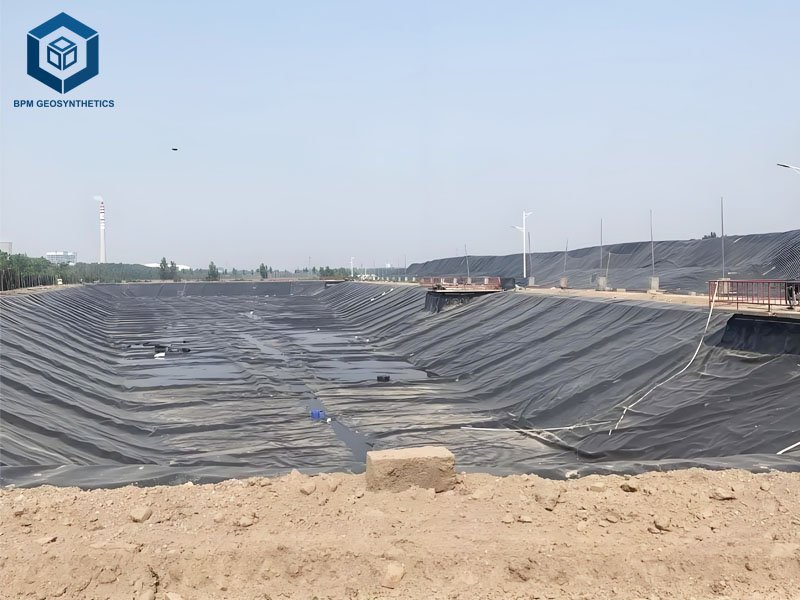
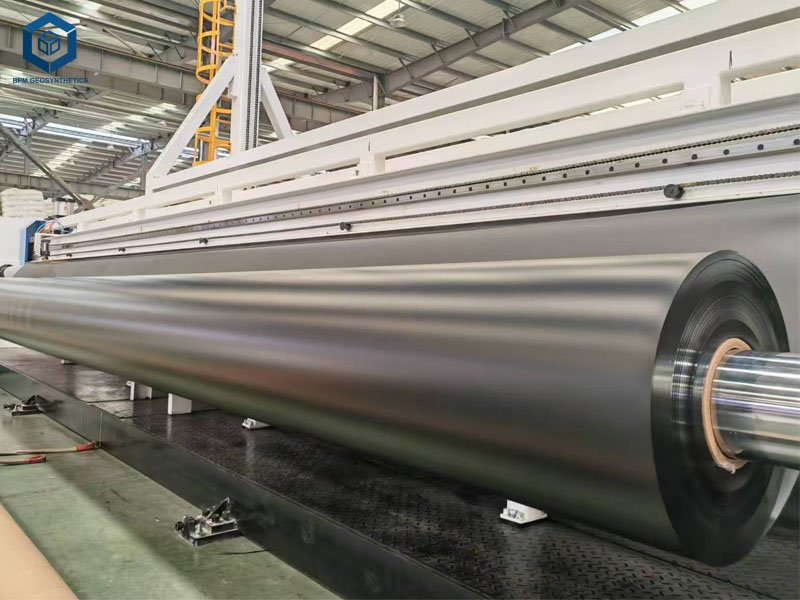
8. Main Considerations When Choosing the Best Geomembrane
Selecting a geomembrane for dredging requires careful evaluation:
- Application: HDPE (1.5–2.0 mm) for CDFs, LLDPE (0.5–1.0 mm) for ponds, PVC for decorative dredging sites.
- Site Conditions: Assess subgrade roughness, slope stability, and thermal variations. Textured HDPE adds 10% friction on slopes.
- Chemical Exposure: Test compatibility per ASTM D5322 ($500–$1,000) for dredged sediments.
- UV Exposure: Use EPDM or UV-stabilized HDPE for exposed CDFs, or cover with soil ($1–$3/m²).
- Thickness: Thicker liners (≥1.5 mm) for landfills, thinner (0.5 mm) for ponds. Thicker liners cost 20% more but last 30% longer.
- Budget: HDPE costs $1–$3/m², PVC $0.5–$2/m². Pre-fabricated liners save 15% for small projects.
- Certifications: Ensure ASTM D7931, ISO 9001, or CE compliance for regulated dredging projects.
Pro Tip: Conduct trial welds and ELLS surveys to verify seam integrity, saving 10% on repairs, as demonstrated in a 2023 US dredging project.
9. Is Geomembrane Waterproof?
Yes, geomembranes are waterproof, with hydraulic conductivities of 10⁻¹² to 10⁻¹⁵ m/s, 100 times lower than clay. They prevent leakage in 99% of properly installed systems, per ASTM D5887. In dredging, HDPE liners in CDFs achieve 99.9% waterproofing when properly installed. However, punctures or seam failures can increase leakage risks by 15%. Regular inspections and testing ensure reliability.
10. Final Thoughts
Geomembranes are essential for dredging and containment, offering unmatched impermeability and durability in CDFs, landfills, and ponds. Despite their advantages, challenges like puncture vulnerability, UV degradation, and seam imperfections demand careful planning. HDPE, with a 55% market share, delivers 50–100-year lifespans when properly managed. By selecting the right material, thickness, and adhering to ASTM standards, dredging professionals can achieve 99% containment efficiency while controlling costs.
Contact BPM Geomembrane for high-quality geomembranes tailored to your dredging project.

